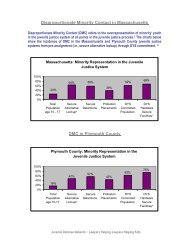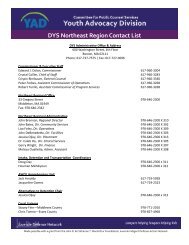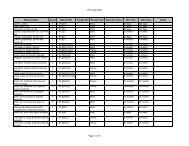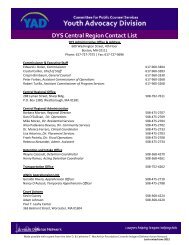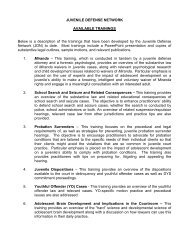States rethink 'adult time for adult crime' - the Youth Advocacy Division
States rethink 'adult time for adult crime' - the Youth Advocacy Division
States rethink 'adult time for adult crime' - the Youth Advocacy Division
You also want an ePaper? Increase the reach of your titles
YUMPU automatically turns print PDFs into web optimized ePapers that Google loves.
What Makes Teens Tick; A flood of hormones, sure. But also a host of struct...plain <strong>the</strong> behaviors that make adolescence so exciting--and so exasperating<br />
cadavers.) Each of <strong>the</strong> Mann boys will be scanned three <strong>time</strong>s. The first scan is a<br />
quick survey that lasts one minute. The second lasts two minutes and looks <strong>for</strong> any<br />
damage or abnormality. The third is 10 minutes long and taken at maximum<br />
resolution. It's <strong>the</strong> money shot. Giedd watches as Anthony's brain appears in cross<br />
section on a computer screen. The machine scans 124 slices, each as thin as a dime.<br />
It will take 20 hours of computer <strong>time</strong> to process <strong>the</strong> images, but <strong>the</strong> analysis is<br />
done by humans, says Giedd. "The human brain is still <strong>the</strong> best at pattern<br />
recognition," he marvels.<br />
Some people get nervous as <strong>the</strong> MRI machine clangs noisily. Claustrophobes panic.<br />
Anthony, lying still in <strong>the</strong> soul of <strong>the</strong> machine, simply falls asleep.<br />
CONSTRUCTION AHEAD<br />
One reason scientists have been surprised by <strong>the</strong> ferment in <strong>the</strong> teenage brain is<br />
that <strong>the</strong> brain grows very little over <strong>the</strong> course of childhood. By <strong>the</strong> <strong>time</strong> a child is 6,<br />
it is 90% to 95% of its <strong>adult</strong> size. As a matter of fact, we are born equipped with<br />
most of <strong>the</strong> neurons our brain will ever have--and that's fewer than we have in<br />
utero. Humans achieve <strong>the</strong>ir maximum brain-cell density between <strong>the</strong> third and sixth<br />
month of gestation--<strong>the</strong> culmination of an explosive period of prenatal neural<br />
growth. During <strong>the</strong> final months be<strong>for</strong>e birth, our brains undergo a dramatic pruning<br />
in which unnecessary brain cells are eliminated. Many neuroscientists now believe<br />
that autism is <strong>the</strong> result of insufficient or abnormal prenatal pruning.<br />
What Giedd's long-term studies have documented is that <strong>the</strong>re is a second wave of<br />
proliferation and pruning that occurs later in childhood and that <strong>the</strong> final, critical part<br />
of this second wave, affecting some of our highest mental functions, occurs in <strong>the</strong><br />
late teens. Unlike <strong>the</strong> prenatal changes, this neural waxing and waning alters not <strong>the</strong><br />
number of nerve cells but <strong>the</strong> number of connections, or synapses, between <strong>the</strong>m.<br />
When a child is between <strong>the</strong> ages of 6 and 12, <strong>the</strong> neurons grow bushier, each<br />
making dozens of connections to o<strong>the</strong>r neurons and creating new pathways <strong>for</strong> nerve<br />
signals. The thickening of all this gray matter--<strong>the</strong> neurons and <strong>the</strong>ir branchlike<br />
dendrites--peaks when girls are about 11 and boys 12 1/2, at which point a serious<br />
round of pruning is under way. Gray matter is thinned out at a rate of about 0.7% a<br />
year, tapering off in <strong>the</strong> early 20s. At <strong>the</strong> same <strong>time</strong>, <strong>the</strong> brain's white matter<br />
thickens. The white matter is composed of fatty myelin sheaths that encase axons<br />
and, like insulation on a wire, make nerve-signal transmissions faster and more<br />
efficient. With each passing year (maybe even up to age 40) myelin sheaths thicken,<br />
much like tree rings. During adolescence, says Giedd, summing up <strong>the</strong> process, "you<br />
get fewer but faster connections in <strong>the</strong> brain." The brain becomes a more efficient<br />
machine, but <strong>the</strong>re is a trade-off: it is probably losing some of its raw potential <strong>for</strong><br />
learning and its ability to recover from trauma.<br />
Most scientists believe that <strong>the</strong> pruning is guided both by genetics and by a use-it-orlose-it<br />
principle. Nobel prizewinning neuroscientist Gerald Edelman has described<br />
that process as "neural Darwinism"--survival of <strong>the</strong> fittest (or most used) synapses.<br />
How you spend your <strong>time</strong> may be critical. Research shows, <strong>for</strong> instance, that<br />
practicing piano quickly thickens neurons in <strong>the</strong> brain regions that control <strong>the</strong><br />
fingers. Studies of London cab drivers, who must memorize all <strong>the</strong> city's streets,<br />
show that <strong>the</strong>y have an unusually large hippocampus, a structure involved in<br />
memory. Giedd's research suggests that <strong>the</strong> cerebellum, an area that coordinates<br />
both physical and mental activities, is particularly responsive to experience, but he<br />
warns that it's too soon to know just what drives <strong>the</strong> buildup and pruning phases.<br />
He's hoping his studies of twins will help answer such questions: "We're looking at<br />
what <strong>the</strong>y eat, how <strong>the</strong>y spend <strong>the</strong>ir <strong>time</strong>--is it video games or sports Now <strong>the</strong> fun<br />
begins," he says.<br />
No matter how a particular brain turns out, its development proceeds in stages,<br />
generally from back to front. Some of <strong>the</strong> brain regions that reach maturity earliest--<br />
through proliferation and pruning--are those in <strong>the</strong> back of <strong>the</strong> brain that mediate<br />
direct contact with <strong>the</strong> environment by controlling such sensory functions as vision,<br />
hearing, touch and spatial processing. Next are areas that coordinate those<br />
file:///L|/JDN/Brain%20Resources/Brain%20Developmen...iling%20Packet/8.%20What%20Makes%20Teens%20Tick.htm (3 of 8)8/16/2006 4:44:18 PM





